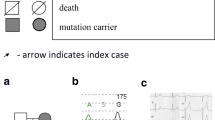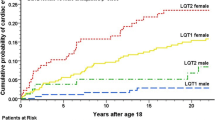Summary
In order to assess the clinical manifestations and electrocardiogram (ECG) characteristics of Chinese long QT syndrome (LQTS) patients and describe the phenotype-genotype correlation, the subjects from 5 congenital LQTS families underwent clinical detailed examination including resting body surface ECG. QT interval and transmural dispersion of repolarization (TDR) were manually measured. Five families were genotyped by linkage analysis (polymerase chain reacting-short tandem repeat, PCR-STR). The phenotype-genotype correlation was analyzed. Four families were LQT2, 1 family was LQT3. Twenty-eight gene carriers were (14 males and 14 females) identified from 5 families. The mean QTc and TDRc were 0.56±0.04 s (range 0.42 to 0.63) and 0.16±0. 04 s (range 0.09 to 0.24) respectively. 35.7% (10/28) had normal to borderline QTc (≦0.460 s). There was significant difference in QTc and TDRc between the patients with symptomatic LQTS and those with asymptomatic LQTS, and there was significant difference in TDRc between the asymptomatic patients and normal people also. A history of cardiac events was present in 50% (14/28), including 9 with syncope, 2 with sudden death (SD) and occurred in the absence of β-blocker. Three SDs occurred prior to the diagnosis of LQTS and had no ECG record. Two out of 5 SDs (40%) occurred as the first symptom. Typical LQT2 T wave pattern were found in 40% (6/15) of all affected members. The appearing-normal T wave was found in one LQT3 family. Low penetrance of QTc and symptoms resulted in diagnostic challenge. ECG patterns and repolarization parameters may be used to predict the genotype in most families. Genetic test is very important for identification of gene carriers.
Similar content being viewed by others
References
Schwartz P J. Idiopathic long QT syndrome: progress and questions. Am Heart J, 1985, 109:399
Moss A J, Schwartz P J, Crampton R Set al. The long QT syndrome: Prospective longitudinal study of 328 families. Circulation, 1991, 84: 1136
Vincent G M, Zhang L, Timothy K Wet al. Long QT syndrome patients with normal to borderline prolonged QTc interval are at risk for syncope, cardiac arrest and sudden death. Circulation, 1999, 100: 1272
Zareba W, Moss A J, Schwartz P Jet al. for the International Long-QT Syndrome Registry Research Group. Influence of the genotype on the clinical course of the long QT syndrome. N Engl J Med, 1998, 339:960
Vincent G M, Timothy K, Leppert Met al. The spectrum of symptoms and QT intervals in carriers of the gene for the long QT syndrome. N Engl J Med, 1992, 327:816
Priori S G, Napolitano C, Schwartz P J. Low penetrance in the long-QT syndrome: clinical impact. Circulation, 1999, 99:529
Schwartz P J, Moss A J, Vincent G Met al. Diagnostic criteria for long QT syndrome: An Update. Circulation, 1993, 88:782
Yan G X, Antzelevitch C. Cellular basis for the normal T wave and electrocardiographic manifestations of the long-QT syndrome. Circulation, 1998, 98: 1928
Antzelevitch C, Shimizu N, Yan G Xet al. The M cell: Its contribution to the ECG and to normal and abnormal electrical function of the heart. J Cardiovase Electrophysiol, 1999, 10:1124
Lathrop G M, Lalouel J M. Easy calculations of Lod scores and genetics risks on small computers. Am J Hum Genet, 1984: 460
Ackerman M J. The long QT syndrome: ion channel disease of the heart. Mayo Clin Proc. 1998, 73:250
Garson A J, Dick M I, Fournier Aet al. The long QT syndrome in children: an international study of 287 patients. Circulation, 1993, 87:1866
Moss A J. Prolonged QT interval syndromes. JAMA, 1986, 256: 2985
Salen P, Nadkarini V. Congenital long QT syndrome: a case report illustrating diagnostic pitfalls. J Emerg Med. 1999, 17:859
Vincent G M. The molecular genetics of the long QT syndrome: genes causing fainting and sudden death. Annu Rev Med, 1998, 49:263
Moss A J, Zareba W, Benhorin Jet al. ECG T wave patterns in genetically forms of the hereditary long QT syndrome. Circulation, 1995, 92:2929
Zhang L, Katherine W, Timothy B Set al. Spectrum of ST-T wave patterns and repolarization parameters in congenital long QT syndrome. Circulation, 2000, 102: 2849
Author information
Authors and Affiliations
Additional information
LIAN Jiangfang, female, born in 1964, Doctor in Charge, M. D., Ph.D.
This project was supported by grants from National Natural Sciences Foundation of China (No. 39760323 and 3100067) and Shaan'xi Natural Sciences Foundation (No. 2003C210).
Rights and permissions
About this article
Cite this article
Jiangfang, L., Changcong, C., Xiaolin, X. et al. Clinical characteristics of 5 chinese LQTS families and phenotype-genotype correlation. Current Medical Science 24, 208–211 (2004). https://doi.org/10.1007/BF02831990
Received:
Published:
Issue Date:
DOI: https://doi.org/10.1007/BF02831990




